ASUS TUF Z97 Mark S Motherboard Review: The Arctic Camo Special Edition
by Ian Cutress on November 10, 2014 10:00 AM EST- Posted in
- Motherboards
- Asus
- TUF
- Z97
- Sabertooth
CPU Benchmarks
Readers of our motherboard review section will have noted the trend in modern motherboards to implement a form of MultiCore Enhancement / Acceleration / Turbo (read our report here) on their motherboards. This does several things, including better benchmark results at stock settings (not entirely needed if overclocking is an end-user goal) at the expense of heat and temperature. It also gives in essence an automatic overclock which may be against what the user wants. Our testing methodology is ‘out-of-the-box’, with the latest public BIOS installed and XMP enabled, and thus subject to the whims of this feature. It is ultimately up to the motherboard manufacturer to take this risk – and manufacturers taking risks in the setup is something they do on every product (think C-state settings, USB priority, DPC Latency / monitoring priority, memory subtimings at JEDEC). Processor speed change is part of that risk, and ultimately if no overclocking is planned, some motherboards will affect how fast that shiny new processor goes and can be an important factor in the system build.
For reference the ASUS TUF Z97 Mark S in our setup, with BIOS 2102, did implement a form of MultiCore Turbo.
Point Calculations – 3D Movement Algorithm Test: link
3DPM is a self-penned benchmark, taking basic 3D movement algorithms used in Brownian Motion simulations and testing them for speed. High floating point performance, MHz and IPC wins in the single thread version, whereas the multithread version has to handle the threads and loves more cores.
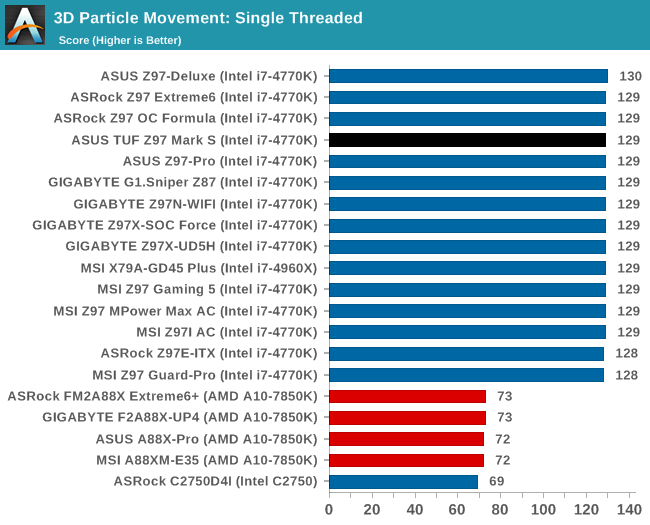
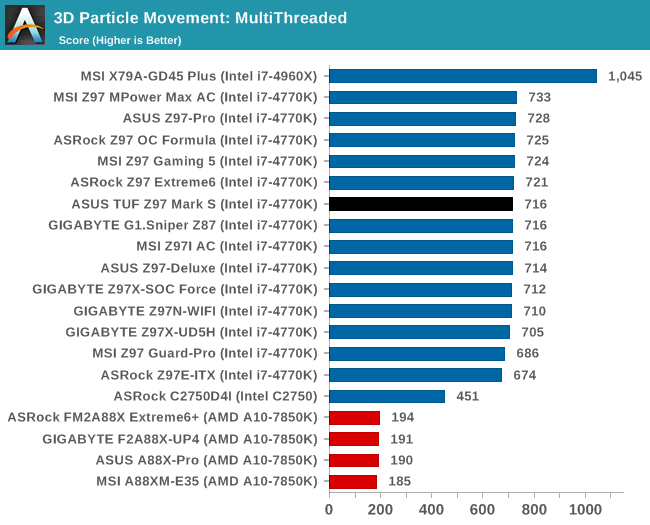
Compression – WinRAR 5.0.1: link
Our WinRAR test from 2013 is updated to the latest version of WinRAR at the start of 2014. We compress a set of 2867 files across 320 folders totaling 1.52 GB in size – 95% of these files are small typical website files, and the rest (90% of the size) are small 30 second 720p videos.
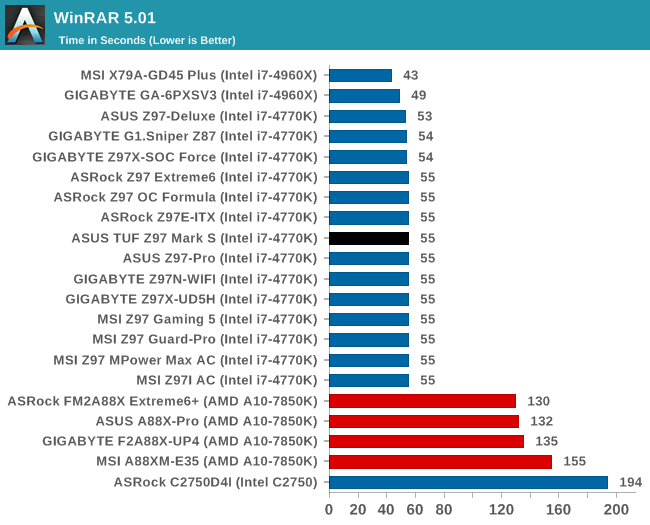
Image Manipulation – FastStone Image Viewer 4.9: link
Similarly to WinRAR, the FastStone test us updated for 2014 to the latest version. FastStone is the program I use to perform quick or bulk actions on images, such as resizing, adjusting for color and cropping. In our test we take a series of 170 images in various sizes and formats and convert them all into 640x480 .gif files, maintaining the aspect ratio. FastStone does not use multithreading for this test, and thus single threaded performance is often the winner.

Video Conversion – Handbrake v0.9.9: link
Handbrake is a media conversion tool that was initially designed to help DVD ISOs and Video CDs into more common video formats. The principle today is still the same, primarily as an output for H.264 + AAC/MP3 audio within an MKV container. In our test we use the same videos as in the Xilisoft test, and results are given in frames per second.
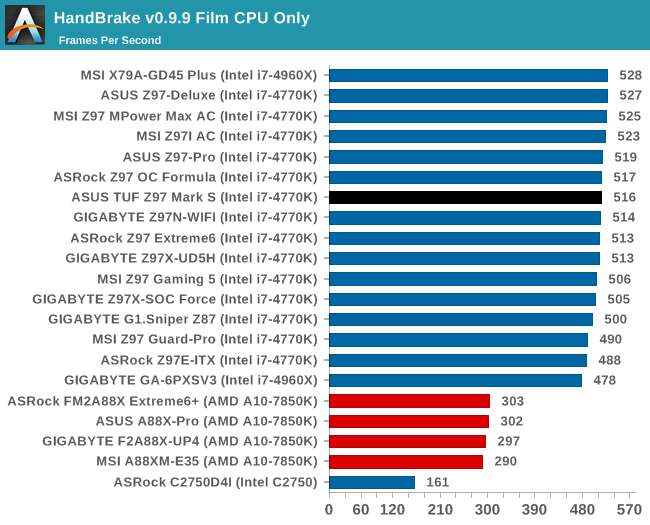

Rendering – PovRay 3.7: link
The Persistence of Vision RayTracer, or PovRay, is a freeware package for as the name suggests, ray tracing. It is a pure renderer, rather than modeling software, but the latest beta version contains a handy benchmark for stressing all processing threads on a platform. We have been using this test in motherboard reviews to test memory stability at various CPU speeds to good effect – if it passes the test, the IMC in the CPU is stable for a given CPU speed. As a CPU test, it runs for approximately 2-3 minutes on high end platforms.
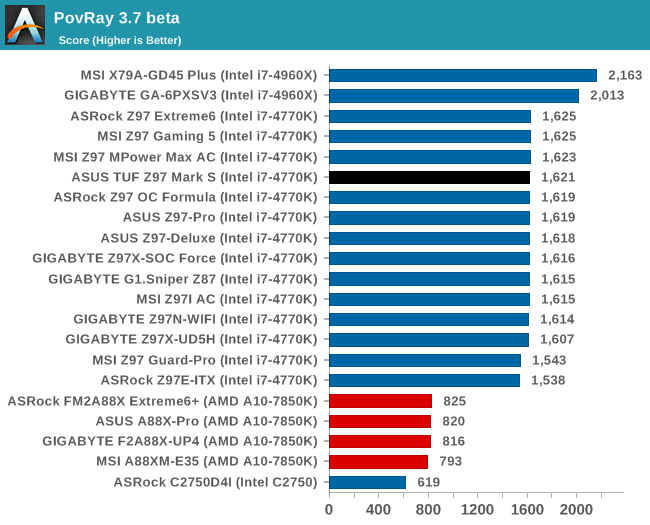
Synthetic – 7-Zip 9.2: link
As an open source compression tool, 7-Zip is a popular tool for making sets of files easier to handle and transfer. The software offers up its own benchmark, to which we report the result.
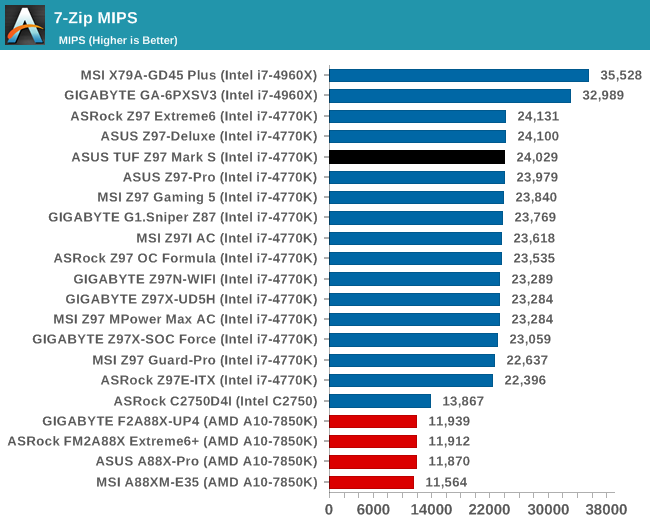










45 Comments
View All Comments
ZeDestructor - Monday, November 10, 2014 - link
I also live in the Australian summer, with no aircon, so 40°C ambient is just fine as well.HanzNFranzen - Monday, November 10, 2014 - link
Actually, I always thought that the cover was a good idea because the small air space between it and the motherboard would insure that all airflow being pulled through is in contact with the components which would cool better. Perhaps I'm thinking about it wrong though.monkeydelmagico - Monday, November 10, 2014 - link
I've got a previous gen z87 sabertooth and can say that the plastic shroud is a royal pain when it comes time to swap fans or gpu. The shrouds make getting your fingers in or around components very difficult.Otherwise it's a great mobo.
LtPage1 - Monday, November 10, 2014 - link
Looks like cheap, childish plastic to me.To each his own, I suppose.
Egbert Souse - Tuesday, November 11, 2014 - link
I agree...looks like it should include little plastic soldiers.twizzlebizzle22 - Monday, November 10, 2014 - link
Not read this yet. I just wanted to comment to tell you my pushbullet channel worked. The anandtech RSS feed and pushes me any articles with the word "review" in the title.I read everything on this site usually, but I like the reviews best of all!
ezorb - Monday, November 10, 2014 - link
I love the look of this and want it in my life, BUT, I hate fans on motherboards, they are always cheep and die young, or they are good, and scream. So i will not be buying this otherwise Awesome board.Jon Tseng - Monday, November 10, 2014 - link
Hmmm... But weren't we taught in Physics class that white is a poor colour for radiating heat???Back to black!
AnnihilatorX - Monday, November 10, 2014 - link
To be honest black or white the color won't make much difference because it's made of plastic. If they are metal on the other hand it may be detectable, albeit not much, given thermal gradient of motherboard components aren't that high anyway.WithoutWeakness - Monday, November 10, 2014 - link
Fans blowing air over the surface of components cools by convection and isn't impacted by color. You're going to get far more heat transfer in a traditional PC from convection than you are from radiation.